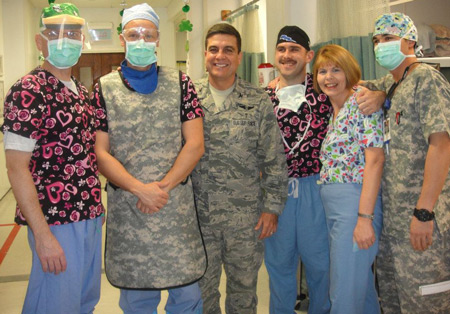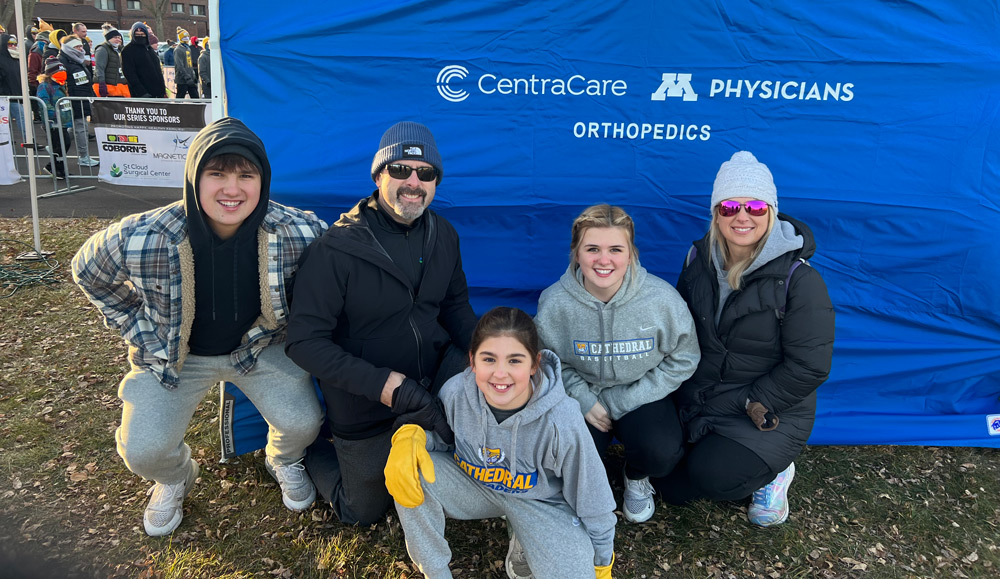From Flight School to Medical School, Orthopedic Surgeon Envisions Legacy Program in Central Minnesota
The path into medicine hasn’t been a straight arrow for CentraCare M Physicians Orthopedic Surgeon Patrick Osborn, MD, FAOA, FACS. A national expert in orthopedic trauma care, his career started in the United States Air Force (USAF), learning firsthand the challenges of treating combat injuries and how to lead a large organization that cares for patients with the most complex injuries.
Now, he’s bringing the lessons learned on America’s battlefields back home to injured civilian patients, where he’s leading a team of surgeons in Central Minnesota to create the premier destination for orthopedic care.
Hailing from Rochester, Minn., Dr. Osborn and his family were no strangers to the medical industry. “My parents both worked for Mayo Clinic. Medicine has always been a big part of our family.”
Yet, the surgeon admits he hadn’t originally contemplated a career in medicine. “From an early age, I intended to join the military. After high school, I went to the U.S. Air Force Academy and then became an officer in the U.S. Air Force.”
U.S. Air Force Academy
From the beginning, he had his sights set on flying. “My kids will tell you it’s because I was a nerd, and I was into war games that fostered that interest,” he smiled. “My dad has said that I made my decision to go into the military in kindergarten when we were in Colorado Springs, and I saw the Air Force Academy for the first time. I said I was going to go there and sure enough, that’s where I started my military life.”
Dr. Osborn decided to pursue medicine as a career relatively late in his undergraduate studies at Air Force. In his junior year, he switched majors to complete the coursework needed for medical school. “It was a daunting challenge to undertake the additional classwork, but it taught excellent habits in preparation and time management,” he remembers. Those habits paid off when he was eventually accepted to the University of Minnesota Medical School.
U.S. Air Force Pilot
He chose instead to pursue his original career goal and was given the chance to attend pilot training at Laughlin Air Force Base, Del Rio, Texas, as a student pilot after graduation from the Academy. “Pilot training and flying for the USAF were once-in-a-lifetime opportunities. I decided that I could always go back to medical school.”
However, flying didn’t challenge him as he’d hoped, and he started feeling another pull toward medical school.
“I didn’t enjoy flying as a career. There was too much doing the same thing every day. I like a new challenge regularly — that’s a large part of why I’ve specialized in orthopedic trauma.”
Medical School
Cutting his flying assignment in Grand Forks, N.D., short, he applied to the University of Texas at Houston Medical School and was accepted under the military’s Health Professions Scholarship Program. Dr. Osborn was drawn to surgical disciplines, and orthopedics particularly excited and challenged him.
After graduating from medical school, he completed his residency in Orthopedic Surgery at the University of Colorado in Denver.
Military Medical Career
His first duty station as a military orthopedic surgeon was at Osan Air Base in South Korea.
Being the sole Air Force orthopedic surgeon on the Korean peninsula was a challenge for a new surgeon. “The closest military orthopedic surgery support was over an hour away,” he recalls. “Being on my own as a surgeon was invaluable and instilled in me a great deal of confidence.”
Upon returning to the U.S., he completed more training in orthopedic foot and ankle surgery and orthopedic trauma in Charlotte, N.C. “I consider myself lucky to have trained at two of the best fellowship programs in the country,” he said.
 Dr. Osborn became the residency program director at Brooke Army Medical Center (BAMC), San Antonio, the largest hospital in the Department of Defense.
Dr. Osborn became the residency program director at Brooke Army Medical Center (BAMC), San Antonio, the largest hospital in the Department of Defense.
He led a faculty of over 20 surgeons who trained 30 resident surgeons every year, the most of any military orthopedic surgery training program. “That was my first dream job. Those skills apply directly to what I’m doing now.”
He deployed to Afghanistan himself, providing life-saving care for those wounded and injured in combat. “Nothing quite prepares you for being deployed. The injuries are regularly more devastating and complex than anything seen in U.S. civilian hospitals. You must have the right mindset for what you’re doing.”
Preserving and expanding what he calls the “trauma mindset” were the motivations for Dr. Osborn’s research on sustaining orthopedic critical wartime skills in the military health system and the impacts of training and duty assignment on combat trauma care patient outcomes.
“Surgical skills are not always technically difficult, but decision-making is. You mustn’t freeze, panic or be indecisive while doing your best to not make wrong decisions. A surgeon in a war zone must have the confidence to make incredibly difficult decisions in a short time.”
That’s why Dr. Osborn teaches those skills to others early in their career. “Certainly, the biggest advances in orthopedics, trauma and critical care surgery come out of wartime,” he said. “Maintaining that skill set and knowledge base was important to me in training residents.”
Leading a Large Organization
After more than six years directing the orthopedic training program, Dr. Osborn took another command position at BAMC.
As Surgeon-in-Chief, Osborn directed roughly 1,700 people who provided care to trauma and other surgical patients.
He worked directly with city and state government officials to coordinate regional trauma care and the response to the COVID pandemic over 22,000 square miles (about twice the area of Vermont) in South Texas.
After 13 years in San Antonio, Dr. Osborn retired from the Air Force as a Colonel in September of 2022.
CentraCare M Physicians Orthopedics
He moved to Minnesota in July 2023 to work with the surgical team at CentraCare M Physicians Orthopedics because he was inspired by the health system’s vision.
“My wife and I knew that this was exactly what I was looking for. It is building something — the nucleus is there. The opportunity to help build a legacy program and platform was incredibly attractive.”
Dr. Osborn leads a team of orthopedic surgeons who provide subspecialty orthopedic expertise for CentraCare. “We are creating the premiere destination for musculoskeletal care in Central Minnesota.”
A strong partnership with the University of Minnesota has helped CentraCare M Physicians Orthopedics grow over the last two years from three to 10 surgeons.
They are the official sports medicine provider for St. Cloud State University Athletics and the St. Cloud Rox baseball team in the Northwoods League.
“Patients want to get care close to home. They do not want to go to the Twin Cities, but they want the best care available,” he acknowledged. “We are providing that next-level care.”
He is incredibly excited to be an involved leader in the area. “We are a part of this tight-knit community. All the M Physicians team live here; we are not ‘mercenaries’ from the metro. We have families that work in the community, go to church here and many of us have kids in schools and on sports teams. We are fully invested in our home which helps the health of people in Central Minnesota.”
University of Minnesota Medical School in St. Cloud
He is equally excited about being part of the new University of Minnesota medical school branch at its start. “We have a chance to improve orthopedic education early in a doctor’s career.
“Being affiliated with the U of M will encourage research and development of better patient care,” he projects. “This will provide the opportunity for significant innovation and growth of technology, business and jobs in this area.”
